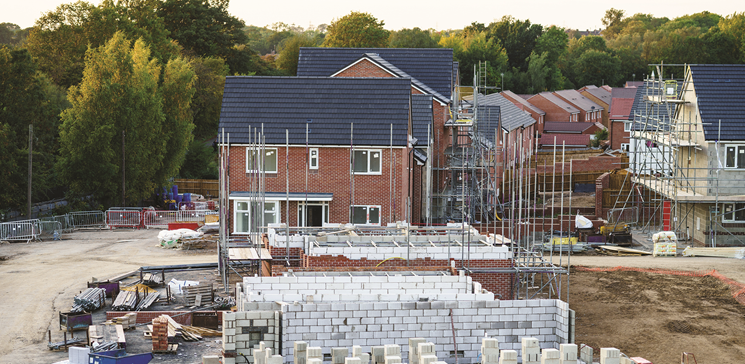Latent Defects Insurance - why it matters
Whenever a developer sells a new home they will guarantee the quality of their design, materials or workmanship by offering extended warranty backed by a specialist insurer, such as the National House Building Council (NHBC). In addition to the NHBC, there are several other providers who cover the whole range of developments such as mixed usage, commercial, and social alongside residential.
Knowing that a defect will be rectified, should it occur within 10 or 12 years of practical completion, is reassuring to the developer, financier, potential owner, occupier or leaseholders. Whether it be a minor or major issue threatening the structure's integrity, knowing it will be rectified provides comfort to all parties. In fact, having Latent Defects Cover may be a condition of the purchase imposed by the financiers. In addition to repairing the structure, the purchase of a warranty can also protect the developer and all professionals involved in the development against reputational damage.
Why relying only on collateral warranties could leave you out of pocket
Given the benefits to financiers, developers and future owners alike, the arrangement of Latent Defects Cover can be a wise commercial decision. There can be a tendency to rely on collateral warranties, but the first hurdle is to try to establish which party is responsible for the damage.
It is often incredibly difficult to decide whether it is a faulty design, faulty workmanship or faulty materials, and in many cases, it can be a combination of any or all of these factors which may take a very long time to establish. Also, not all parties to a contract are included in the collateral warranties, and if a defect is found to be the responsibility of a subcontractor who has not been included within the warranties, there is no right of recourse against them, and therefore, the defect would need to be repaired at the owner’s expense.
In a Latent Defects Policy, there is no need to prove fault
A Latent Defects Policy provides property-specific cover, so you only need to establish that there is an inherent, structural defect rather than how the defect occurred. Finally - and perhaps the most important benefit of a Latent Defects Policy - a specified inherent defect is still protected even if the contractor or other party has become insolvent. In layman’s terms, a collateral warranty is third-party cover, whereas a Latent Defects Policy offers a fully comprehensive policy.
In addition, a Latents Defects Policy will attach to the property itself rather than a specific owner, developer or contractor. Moreover, the policy benefit can be assigned to whichever party owns the property up to the time that the policy ceases, which adds value to the asset owner as well as to the vendor and purchaser.
Nine reasons why Latent Defects Cover is important
Insurance claims can be intricate, especially when significant losses are involved. With Latent Defects Insurance (LRI), a chartered loss adjuster will be assigned to guide you through the process with their extensive expertise. Instead of dealing with paperwork and negotiations, you can focus on rebuilding your business and livelihood. LRI also expedites the claims process, minimising downtime and allowing you to resume operations promptly.
- Financiers will likely insist on this cover as the loan is secured against the building. If an inherent defect becomes apparent, the property value may be prejudiced.
- Rectifying a building defect is more straightforward as the cover is material damage based, and you only need to evidence a specified inherent defect for the claimant to obtain benefit from the policy. You do not have to establish the cause of the defect or prove negligence.
- By avoiding the need to establish negligence, the repair process is more efficient, reducing the overall impact on the owner and maximising returns on assets.
- It avoids the need to seek redress under a collateral warranty that can become a legal issue, thus adding delay and costs with no guarantee that the action will be decided in the claimant’s favour.
- The policy is not tied to any contractor, so if the original speculative developer has gone into liquidation, then there is reassurance that the specified defect will be dealt with.
- When a landlord lets a brand-new build under a standard 5-year+ commercial lease, the lease agreement may state that should the tenant have to vacate the premises due to a major building defect, the landlord may be liable for elements of financial loss suffered by the tenant. Also, the tenant may be able to either enforce a break clause or withhold rent till the defect is rectified. Therefore, the landlord has a considerable potential to suffer a significant loss following a major building defect. By having latent defects cover, the loss is mitigated as the repairs will take place much more quickly, and rectification of the fault does not have to be pursued through the courts. The cover is assignable to a purchaser for a 10- or 12-year policy benefit period.
- Latent Defects Insurance provides cover for inherent defects caused by parties not included in any collateral warranty agreement.
- Cover is flexible and can be extended to include such things as Mechanical and Electricals, loss of income, etc.
- Cover can be extended to include mechanical and electrical installations, which make up a greater percentage of the project cost on new structures.
When should you arrange Latent Defects Cover?
In the build process, it's best to involve insurers at the planning stage, as their input can be invaluable and reduce insurance costs. You can arrange post-construction latent defects, but this option is far more expensive.
Contact us
If you're concerned about latent defects risks and would like to discuss potential insurance solutions with us, please call: 01622 683913 or email: construction@thecleargroup.com







